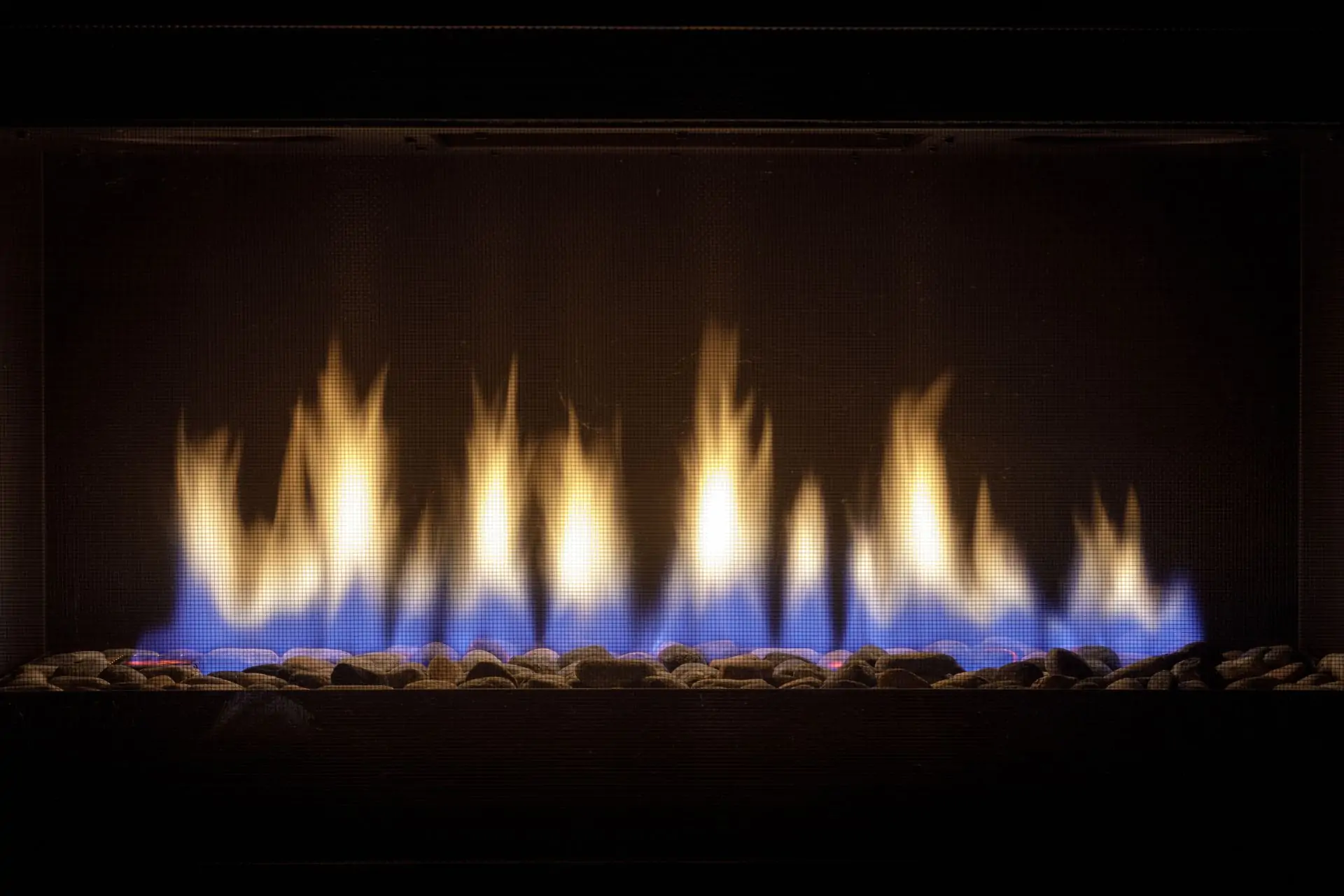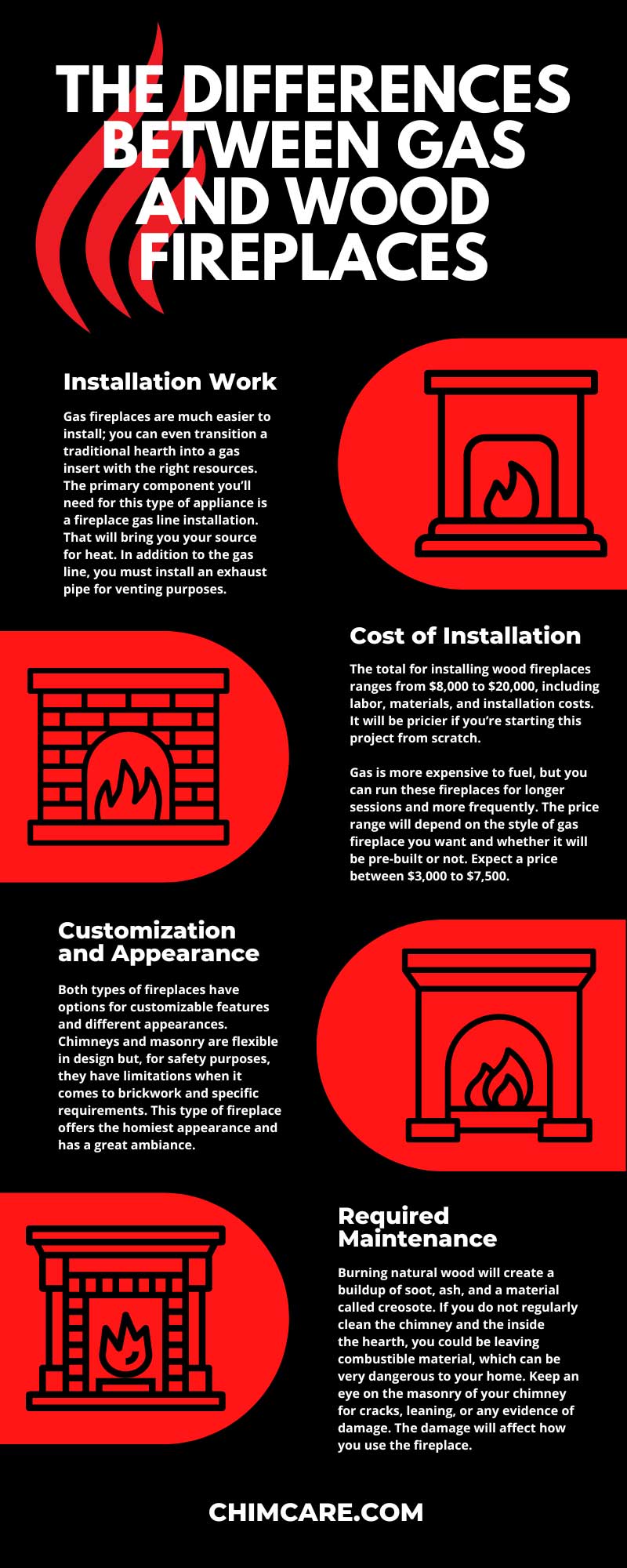
Installation Work
More components make up a traditional wood-burning fireplace than one that uses gas. You will need to install a chimney, firebox, and a chimney cap for protection. A lot goes into building a presentable chimney and brickwork—call a professional service for installation so that you can guarantee the structure is solid and sound.
Gas fireplaces are much easier to install; you can even transition a traditional hearth into a gas insert with the right resources. The primary component you’ll need for this type of appliance is a fireplace gas line installation. That will bring you your source for heat. In addition to the gas line, you must install an exhaust pipe for venting purposes.
Cost of Installation
The difference between traditional wood and gas fireplaces is that the former is more expensive than the latter. However, wood is more affordable if you plan on having numerous fires because you can find and chop your own wood. The total for installing wood fireplaces ranges from $8,000 to $20,000, including labor, materials, and installation costs. It will be pricier if you’re starting this project from scratch.
Gas is more expensive to fuel, but you can run these fireplaces for longer sessions and more frequently. The price range will depend on the style of gas fireplace you want and whether it will be pre-built or not. Expect a price between $3,000 to $7,500.
Customization and Appearance
Both types of fireplaces have options for customizable features and different appearances. Chimneys and masonry are flexible in design but, for safety purposes, they have limitations when it comes to brickwork and specific requirements. This type of fireplace offers the homiest appearance and has a great ambiance.
On the other hand, gas has a wide variety of customizable features so that the insert will fit anywhere in the home. The house will feel more modern with a gas built-in that adds a touch of sophistication. You won’t have the actual fire, but it can appear that way—you can even have ceramic logs that trick your mind into thinking they’re real for a more authentic appearance.
Experience and Aesthetic
Do you want a more natural experience with the smell and noise of a crackling fire? A wood-burning fireplace can give you exactly that. It is the main reason why homeowners will decide on this type of fireplace over gas.
Gas can have a similar glow to natural fire, but there won’t be any noise unless you add ambient sound yourself. Furthermore, you won’t have the lingering smoke smell on your clothes. This appliance is just as welcoming as the traditional option.
Usefulness and Convenience
To build and feed a wood-burning fire, you must put forth a lot of effort to ensure the proper steps are taken. The chimney will need to be clear of debris so that smoke can ventilate out through the flue. In addition, you will need to constantly add fuel to the flames when you want a continuous fire.
Do you want something more simple and mindless? You can turn a gas fireplace on through a remote, and it does not require adding fuel—the gas line will do that job for you! It’s as easy as flipping the ignition switch and letting the appliance do its thing.
Required Maintenance
Burning natural wood will create a buildup of soot, ash, and a material called creosote. If you do not regularly clean the chimney and the inside the hearth, you could be leaving combustible material, which can be very dangerous to your home. Keep an eye on the masonry of your chimney for cracks, leaning, or any evidence of damage. The damage will affect how you use the fireplace.
You most likely guessed it: gas fireplaces are low maintenance and rarely see issues. The biggest problem with these appliances is ensuring that there is no damage to your gas line or valves. While creosote won’t be a factor here, the fireplace will still accumulate a little dust and debris that is easy to wipe away.
Cleaning and Inspections
It is vital that you receive an annual chimney sweep and inspection of your traditional fireplace. The best time to do these is during the warmer months when you don’t plan to use the fireplace often. Creosote and ash will need to be removed regularly to prevent the spread of a fire to your home.
The main component on a gas fireplace you need to clean is the glass panel on the front. After multiple uses, the glass could become foggy and dirty. Clean the glass and dust away any debris from the vents and blower as need be.
Safety Around the Appliance
Never leave a wood-burning fire unattended, or you could risk a spark or ember catching fire elsewhere in the home when you aren’t paying attention. Let the fire die entirely before leaving the room or exiting the home.
The glass door on the gas fireplace can reach incredibly high temperatures when the appliance is running. You may need to install a childproof screen so that kids do not accidentally touch the glass.
Energy Efficiency
Traditional fireplaces need a great deal of insulation within the home to retain the heat. Because the chimney can bring in cold drafts from the outside, wood-burning is not an efficient heating source. Yes, wood is a renewable resource, but more CO2 is continuously released into the air after using this appliance.
Gas is much more efficient and gives off fewer by-products and pollutants. Gas is not a renewable energy source, but it can heat a room and maintain a steady temperature of heat.
Have you given any thought thus far to which fireplace you could see installing in your home? Weigh the pros and cons of each to help make your decision easier. Keep your budget in mind, as well as personal preferences and how much work you’re willing to put into the appliance.

